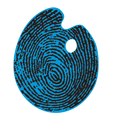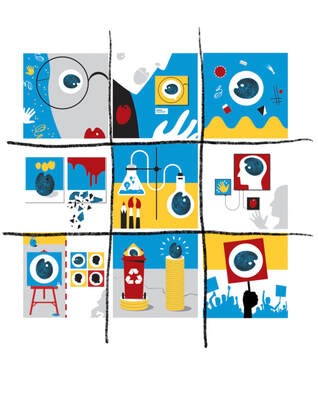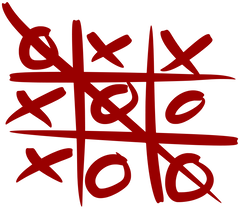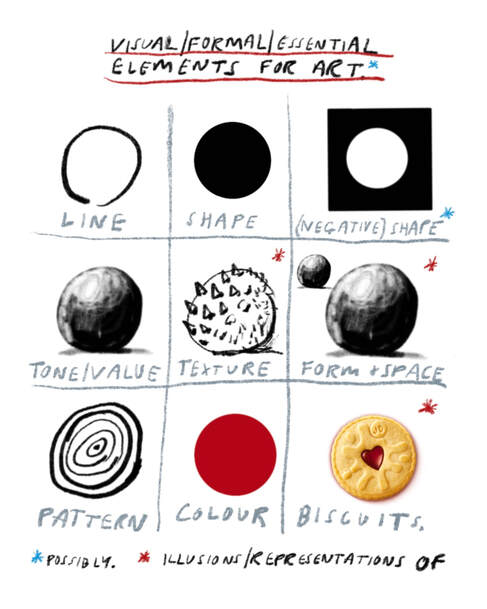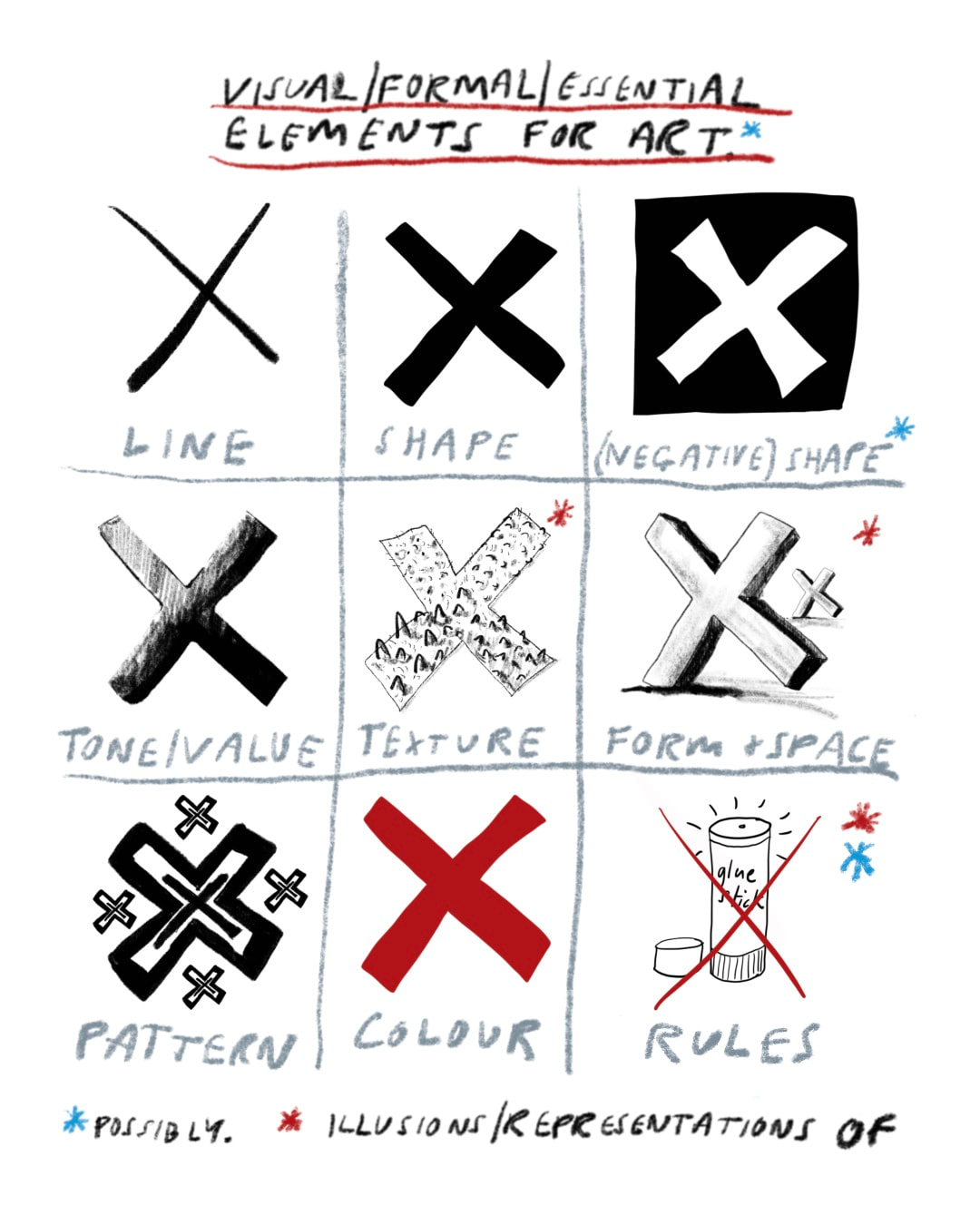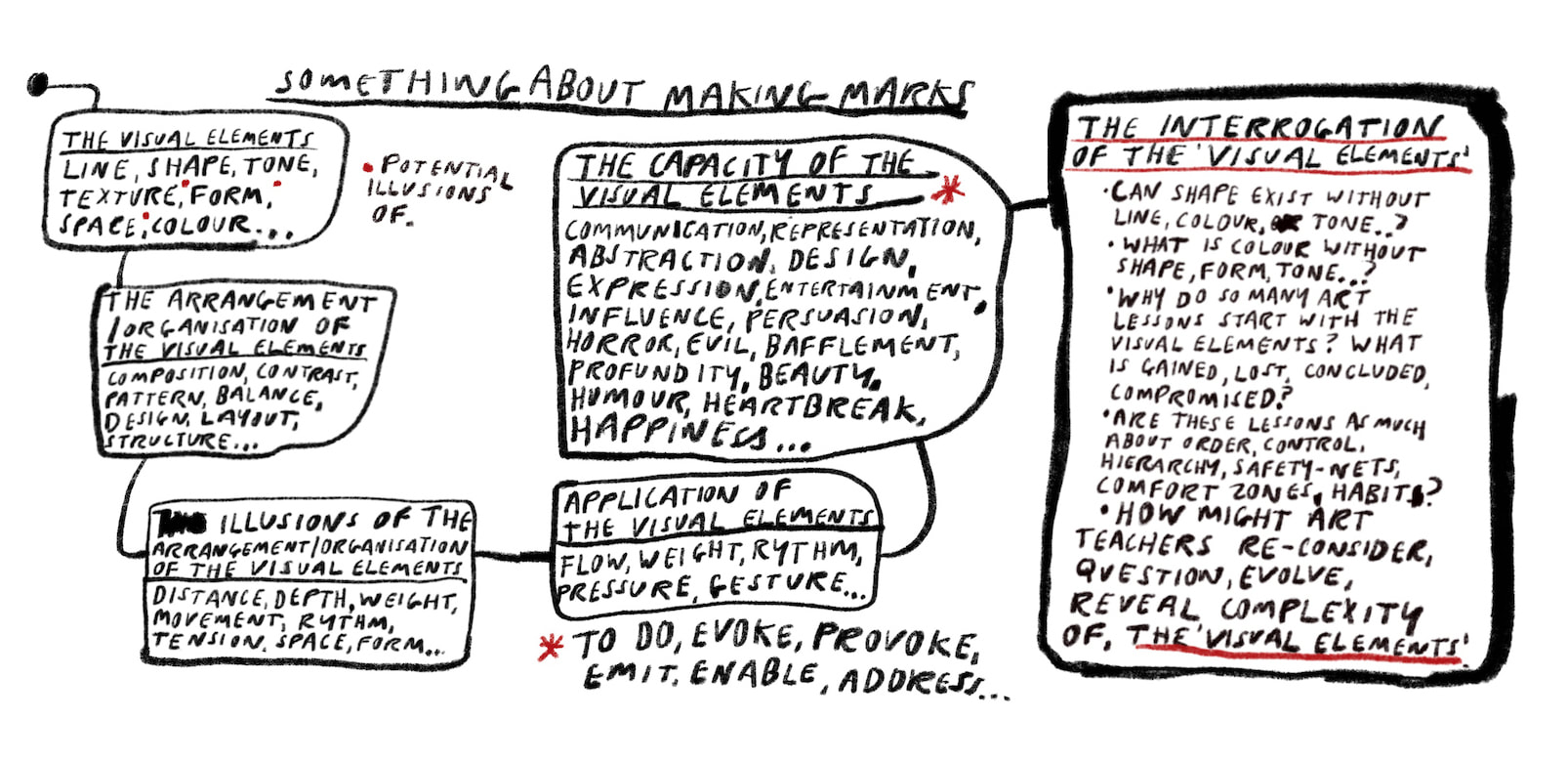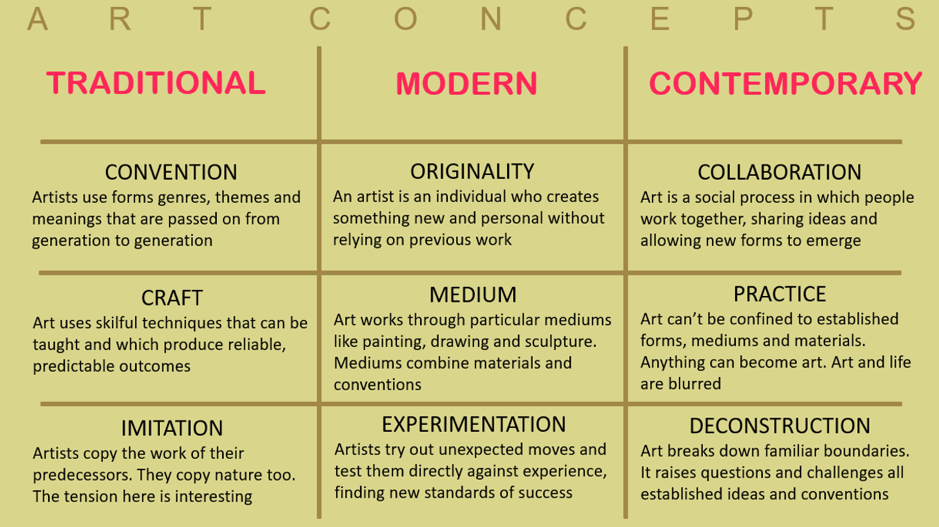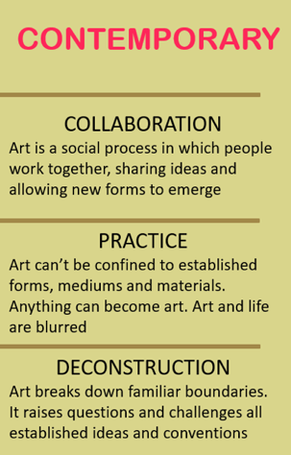TC#1 & TC#5 RESOURCE: NOUGHTS & CROSSES - PLAYING WITH ART (HI)STORIES
tic-tac-toe - make a mark, wait, decide your next move
ABOUT This resource has been written retrospectively in support of a Year 10 and Year 12 project and is an extension of this lesson exploring 'Grids'. It links directly with TC1: Artists make marks, drawing our attention , but also reaches into many other TCs, notably TC3: Art has its own vocabulary, shaped across time and space and TC5: Artists play, with materials, ideas, and failure.
themesThe game of Noughts & Crosses (or tic-tac-toe) is used as a starting point for exploring mark making and how/why artists make marks, and also how this has changed over time. Key themes and subject specific vocabulary are introduced and reinforced along the way. The sequence of lessons is presented chronologically here under the following broad (and debatable) titles:
|
PART 1: MARK MAKING AND THE VISUAL FORMAL ELEMENTS
|
A game of Noughts & Crosses is accessible to all. It is quick, playful and collaborative. It also relies on 3 seemingly simple components - grid, cross, circle - which, when you think about it, do have interesting connections to education and art/mark making: The grid is a reoccurring element throughout art and design history (see here) and is associated with order and structure; the cross is synonymous with being 'wrong' or 'incorrect', but is also considered one of the most direct marks made by humankind (e.g. as a basic signature; 'X' marking the spot; as a warning sign etc.); the circle is a universal symbol of purity, perfection and infinity, a shape that artists throughout time have revered and explored.
Each component opens up potential for discussion, research and creative exploration. Noughts and/or crosses can also help to introduce and explore the Visual Elements (sometimes referred to as Formal Elements) in a low-risk, playful and accessible way, as set out below. ('Biscuits' and 'Rules' are not really visual elements, obviously). |
DISCUSSION
The 'Visual Elements' might be best described as 'the information that we see'. These words - line, shape, tone, texture, form, space, pattern, colour - are helpful for making and talking about art. BUT they can also be deployed and explored lazily in art rooms without critical questioning or wider context. With this in mind, consider the following questions:
- Which of these visual elements (when working in 2 dimensions) might be described as illusionary? Why?
- Is it possible for colour to exist (or to make a mark in colour) without line or shape?
- Is it possible to create a pattern without using any other visual elements?
- When an artwork, observation or encounter is explained by/reduced to its visual elements, what else is neglected or overlooked?
- Is it always relevant/important for a student to recognise and identify visual elements of an artwork? What other 'elements' might make up an artwork?
ACTIVITY
- Using noughts and crosses as a starting point, produce a series of experiments exploring the visual elements and ways/means of mark making. This might include pencil, pen, stick & ink, collage, paper and wire sculpture. When a range of noughts and crosses have been created, play-experiment with various compositions. Consider the visual relationships that are created - contrasts, tensions, affinities etc. - and how your eye is led around the grid.
The notes below share subject vocabulary related to this task and their potential context/application. How might these help to explain the creative decisions made?
ACTIVITY
Construct a 3 dimensional response inspired by Noughts & Crosses. The large example below, used as inspiration for subsequent experiments, was constructed from a old boxes/plinths, scrap lengths of wood, unwanted hula-hoops and old netballs from the PE department store. It was then painted with a limited colour palette of black, grey, white and red.
The process of constructing might be described as a collaborative drawing in space. There was no pre-planning or designing, instead, objects were moved, adapted and attached as a form of dialogue between artists, objects and the space it occupies.
The process of constructing might be described as a collaborative drawing in space. There was no pre-planning or designing, instead, objects were moved, adapted and attached as a form of dialogue between artists, objects and the space it occupies.
Is the resulting construction, above, best described as a sculpture, an assemblage, a 'combine' or, potentially, an installation? Follow the links to look at the definitions of these words - the boundaries between them are not always distinct. As it is, I prefer the description a 'drawing (or mark making) in space'. It seems to best suggest the intuitive process of making and its functional, temporary nature (as a reference for what follows).
PART 2: 'Traditional' MARK MAKING
The table above was devised by Neil Walton. You can read more about this here. The following parts of this resource make regular reference to this, but it's also important to note that these 'concepts' or 'categories' are debatable and not definitive. They are also not necessarily chronological. For example, it might be argued that pre-historic art is far from 'traditional' (for example, it might be 'abstract', original; perhaps a consequence of collaboration; not based on representation or imitation) or that the absurd performances of the Dadaists in the early 1900's were 'contemporary' in collaboration, practice and intentions.
ACTIVITY
The task here is to produce a series of studies of the construction that explore and demonstrate (teach and learn, hopefully) 'traditional' drawing skills. Prior to beginning it is worth considering the following questions (also with reference to the table above):
- What makes a drawing 'traditional'?
- What drawing skills, knowledge and techniques have you already been taught or are aware of? How have these been 'passed on' or 'handed down' to you?
- Are 'traditional' drawings always ... of something tangible, observed directly, recognisable, representational, accurate?
|
Develop a series of studies that explore some or all of the following. You might complete your own wider research into the histories of these considerations:
DISCUSSION
|
PART 2: 'MODERN' MARK MAKING
The activities here are in support of an introduction to modernism and 'modern' approaches to art making (Modern Art). For a detailed introduction to this period, see here. This period from the late 1800s until 1950s was one of immense and rapid change. Here are a few key points:
The following activities introduce some key 'Modern' artistic movements and ideas in Western Art, specifically: Cubism, Futurism, Constructivism and Suprematism. Follow the links to read about these in more depth. Important to remember: these are selected starting points; there are plenty of other (hi)stories and 'isms' to explore that also interconnect. 'Primitivism' is one and, as this link suggests, is a problematic word. But it's helpful to have an awareness that whilst (Western) Modernist artists were looking forwards and embracing the future, many were also taking inspiration from the past and from other cultures at the same time. This link explains further.
- The modern era began with the industrial revolution. This led to mass migration with many people moving from rural areas to cities searching for work.
- The invention of many new technologies changed life drastically - engines, factories, electrical power, printing presses, photography, the capacity to travel by train, car, plane ...
- Artists found themselves encountering new (urban) landscapes; new ways of observing (views from fast moving vehicles, for example); exhibited artifacts from other countries (often a result of colonial theft); new technologies and processes, such as photography and printing.
- Artists also found themselves encountering new extremities of emotions, for example, as a consequence of dictatorial regimes, national and international unrest and, consequently, World War I and II.
The following activities introduce some key 'Modern' artistic movements and ideas in Western Art, specifically: Cubism, Futurism, Constructivism and Suprematism. Follow the links to read about these in more depth. Important to remember: these are selected starting points; there are plenty of other (hi)stories and 'isms' to explore that also interconnect. 'Primitivism' is one and, as this link suggests, is a problematic word. But it's helpful to have an awareness that whilst (Western) Modernist artists were looking forwards and embracing the future, many were also taking inspiration from the past and from other cultures at the same time. This link explains further.
ACTIVITY
This activity is an opportunity to introduce Cubism and Futurism, and also how Cubism developed in two distinct phases: initially analytical cubism, and a later phase of cubism known as synthetic cubism.
Cubism was a revolutionary new approach to representing reality invented in around 1907–08 by artists Pablo Picasso and Georges Braque. They brought different views of subjects (usually objects or figures) together in the same picture, resulting in paintings that appear fragmented and abstracted.
Source: Tate Online
Cubism was a revolutionary new approach to representing reality invented in around 1907–08 by artists Pablo Picasso and Georges Braque. They brought different views of subjects (usually objects or figures) together in the same picture, resulting in paintings that appear fragmented and abstracted.
- Analytical cubism ran from 1908–12. Its artworks look more severe and are made up of an interweaving of planes and lines in muted tones of blacks, greys and ochres.
- Synthetic cubism is the later phase of cubism, generally considered to date from about 1912 to 1914, and characterised by simpler shapes and brighter colours. Synthetic cubist works also often include collaged real elements such as newspapers. The inclusion of real objects directly in art was the start of one of the most important ideas in modern art.
Source: Tate Online
Produce a series of responses that experiment with multiple viewpoints and perspectives inspired by Cubism (Analytical and/or Synthetic) and Futurism.
For example:
For example:
- Produce a 10 minute observational drawing of the structure. Once completed, move to a different viewpoint and repeat the task, however, do this on top of your previous drawing. Repeat this activity 3 or four times combining multiple viewpoints. You might choose to use different coloured pencils to do this. Once completed, or even as you are making and layering marks, consider your composition as a whole and how you might overlay lines or add tone to emphasise positive and negative forms, or certain edges, shapes and surfaces.
|
|
|
Following this activity, produce a series of experiments that take inspiration from Constructivism and Suprematism.
|
Constructivism was an austere branch of abstract art, inspired by Cubism, founded by Vladimir Tatlin and Alexander Rodchenko in Russia around 1915. The constructivists believed art should directly reflect the modern industrial world and serve as a force for social good.
Suprematism is the name given by the Russian artist Kasimir Malevich to the abstract art he developed from 1913 characterised by basic geometric forms, such as circles, squares, lines and rectangles, painted in a limited range of colours. Source: Tate Online Consider the following prompts:
|
|
These initial experiments by students, above, can form a helpful introduction to these Modernist movements and ideas. Of course, there are loads of possibilities for further development, not least through more expressive (colourful, painterly, physical) approaches that might introduce art movements such as Fauvism, Expressionism or, in the later stages of Modernism, Abstract Expressionism, which is also relevant to the next section.
PART 3: 'CONTEMPORARY' MARK MAKING
|
It's worth reminding ourselves here of how 'contemporary' approaches might be defined (and the debatable nature of these categories) to help introduce the following themes:
|
These 3 artworks/images, above, are perhaps the most established and direct (hi)stories to lead into the following activities. The notes below offer a brief insight:
- Marcel Duchamp's 'Fountain', his most (in)famous 'readymade' - an upturned urinal, signed with a fictional name, submitted for exhibition and declared by Duchamp as art.
- An image of Jackson Pollock 'action painting', which poses the question: Does the 'art' of an action painter such as Pollock reside in the outcome only, or in the very act of doing - the physicality and 'performance' of making?
- John Maclean's 'Pose Work for Plinths' was originally a humorous and ironic performance in response to what Maclean considered the pompous monumentality of Henry Moore's sculpture work.
ACTIVITIES
|
For this quick experiment, half the class provided instructions for the other half to 'perform' with and within the sculpture. The resulting machine-like actions seemed fitting in response to its Modernist appearance.
|
|
If you are a teacher or artist working in another school and use this resource for inspiration, please do consider sharing your results. You can do this on Instagram by tagging @artpedagogy.
If you would like to make a donation to support our creative projects and the ongoing sharing of resources you can do so via the 'Donate' button here. All feedback and thoughts very welcome.
If you would like to make a donation to support our creative projects and the ongoing sharing of resources you can do so via the 'Donate' button here. All feedback and thoughts very welcome.
